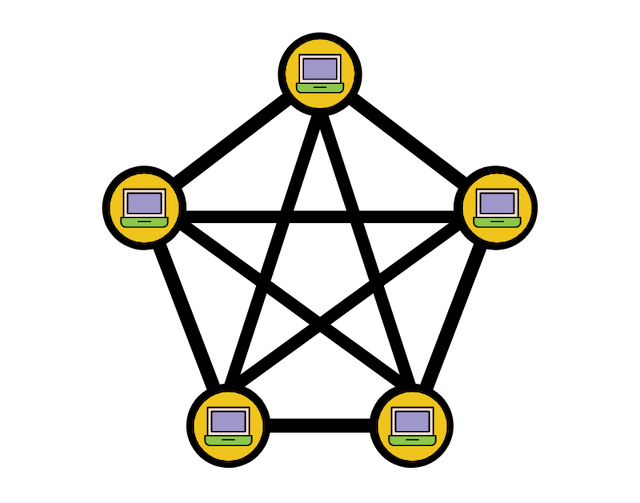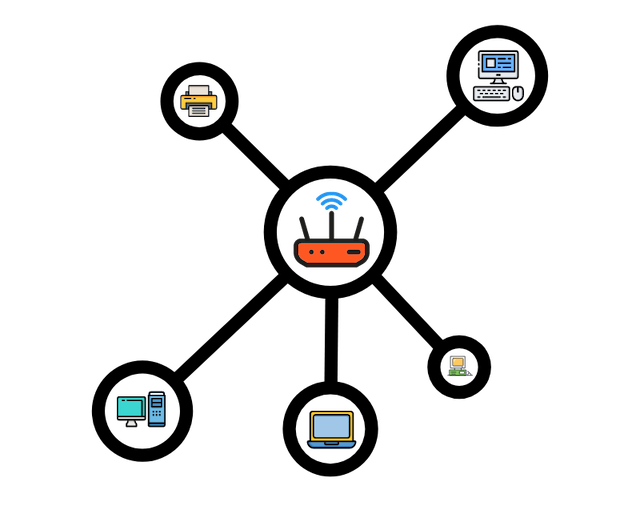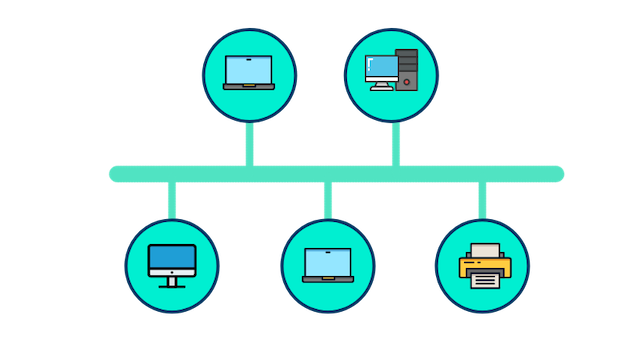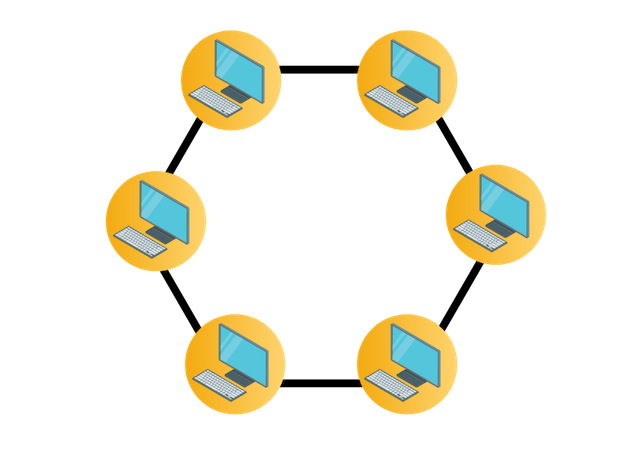Networking Fundamentals Study Guide for the CompTIA Network+
Page 2
Network Topologies and Types
A network is composed of two or more devices that share resources in some manner. Networks can be extremely simple or highly complex depending on the type of network employed and the topology or the manner in which they are connected. Network topologies can be either physical or **logical. You will need to be able to identify and explain the characteristics of common network topologies and types.
Mesh
A mesh is a network topology in which every device in a network is connected to all other devices in the network. A mesh network is not typically used in larger networks due to the sheer number of connections needed to complete the mesh. A mesh network does, however, provide very high fault tolerance.

Star/Hub-and-Spoke
A star topology, also referred to as a hub-and-spoke topology, is a network topology that has all devices connected to a central point, such as a hub, access point, or switch. Star topologies provide the ability to scale easily, and they allow for simpler troubleshooting and fault tolerance if one connection fails. However, star topologies do have a single point of failure in the central point.

Bus
A bus topology, the most simplistic network topology, has a distinct beginning and end point with all devices connected to this single cable. All data flows through this single cable, but only the intended receiving device gets the data. A bus topology is simple to install and cost-effective, but it has no fault tolerance. If the primary cable goes down, the entire network goes down.

Ring
A ring topology connects one device to another device and so forth until it reaches back to the originating device. A ring topology is very similar to a bus topology but can be more expensive to install due to the amount of cabling needed to connect all the devices. A ring topology, like a bus, is not fault tolerant.

Hybrid
A hybrid topology mixes different topologies into a single network. For example, a hybrid mesh creates connections between multiple devices to create redundancy and fault tolerance without connecting all of the devices.
Network Types and Characteristics
A network can be as simple as two devices connected in a single location or as complex as thousands of devices connected over an entire city. The requirements of the network help dictate which type of network would be most appropriate for the situation. Each network type has distinct characteristics that you should be familiar with.
Peer-to-Peer
In a peer-to-peer network, all connected devices are peers, meaning that there is no central authority or server in the network. Each peer acts as its own server and controls its own resources and permissions.
Client-Server
In a client-server network, there is a centralizing authority or server that grants permissions and access to resources. Each connected device does not have authority over its own resources. For example, if computer A wishes to pull data from a database server in the network, the request is sent to the central authority, which evaluates the request and either grants or denies access to the database. Computer A can not directly send the request to the database server. Client-server networks provide increased security and scalability to a network.
Local Area Network (LAN)
A LAN is a network that is confined to a smaller geographical area, such as an office building or a home network. A LAN can also consist of multiple LANs. For example, a hospital might set up a LAN for the entire hospital. Each department, however, could have its own individual LAN that is separate from other department LANs but still contained within the primary LAN.
Metropolitan Area Network (MAN)
A MAN is a network that spans an entire metropolitan area or city via an optical connection. For example, if an internet service provider (ISP) installs high-speed fiber throughout a large city, then all office buildings, homes, retailers, etc., will be connected to the ISP via the fiber connection, creating a MAN.
Wide Area Network (WAN)
A WAN is a network that covers a very wide geographical area. The most well-known example of a WAN is the internet. Every device that connects to the internet becomes part of the WAN.
Wireless Local Area Network (WLAN)
A WLAN is exactly what it sounds like. It is a LAN created through a wireless connection. For example, when a device is connected to the free Wi-Fi at a coffee shop, it becomes part of the WLAN.
Personal Area Network (PAN)
A PAN creates networking connections, either physical or wireless, between devices in a confined or limited area. For example, if a laptop is connected to a projector via a physical cable and a speaker via a Bluetooth connection, that creates a PAN.
Campus Area Network (CAN)
A CAN creates a network over a limited geographical area, such as a college campus or industrial complex. CANs are much smaller in scope than MANs and can be composed of numerous LANs.
Storage Area Network (SAN)
A SAN is designed only for storage systems and connects servers and storage arrays to a centralized storage bank. SANs use different hardware and protocols than other network types, such as LANs, and do not intermingle traffic with other network types.
Software-Defined Wide Area Network (SDWAN)
A SDWAN uses software to create a virtual WAN. All connectivity, devices, and services are managed through the SDWAN controller. SDWANs are often used with WANs to separate the physical WAN from the controlling mechanism.
Multiprotocol Label Switching (MPLS)
MPLS is a WAN protocol that assigns labels to incoming data from the edge of the network, which it then uses to forward the data to and through the network on virtual links. MLPS provides layout flexibility, prioritization of traffic, redundancy, and a one-to-many connection.
Multipoint Generic Routing Encapsulation (mGRE)
mGRE is a protocol used in dynamic multipoint virtual private network (DMVPN) deployments and offered by service providers. mGRE encapsulates data, creates a VPN with the receiving device or devices, sends the encapsulated data through, and then tears down the VPN connection automatically.
Service-Related Entry Point
A service-related entry point is the physical point where the service provider allows the end user to connect to the service provider’s WAN. At this point, the responsibility of upkeep, maintenance, and security stops being the service provider’s responsibility and transfers to the user. For instance, when a home requests to have internet service installed in their home, the service provider is responsible for the transmitting wires up to the home connection point. Anything that occurs after that point is the homeowner’s responsibility.
Demarcation Point
The demarcation point, or demarc point, is the physical point where the service provider passes off responsibility for the connection.
Smartjack
Smartjacks are devices commonly placed at the demarc point, which allows the service provider to run diagnostics up to the demarc point.
Virtual Network Concepts
A virtual network is a network that is created through logical means rather than physical. The devices needed for network creation and function, such as routers and switches, are virtual.
Hypervisor
A hypervisor is the software that is installed directly onto the base components of a device (before the OS) and allows for the creation of multiple virtual machines (VM) on a single device. For example, suppose a hypervisor is installed on a laptop and then creates three VMs, one running a Windows OS, one a Linux OS, and one a MAC OS. The hypervisor, in essence, has created three separate laptops (VMs) on a single laptop. All of the VMs created share the resources of the laptop they are run on.
vSwitch
A vSwitch is a virtual switch that provides the same functionality as a physical switch. The vSwitch is created on the hypervisor and provides Ethernet switching and routing functions.
Virtual Network Interface Card (vNIC)
A vNIC is a virtual networking device created on the hypervisor that allows the device to communicate with the rest of the network virtually. vNICs are necessary for virtual networks since the virtual network cannot install a physical NIC on the device.
Network Function Virtualization (NFV)
NFV takes all the virtual networking devices, such as routers, switches, firewalls, and load balancers, and combines them into a single virtual control point.
Provider Links
A service provider is the entity that provides networking services such as the internet, phones, and cable. The service provider allows for the use of these networking capabilities through various types of connections or links.
Satellite
A satellite link creates a connection via a satellite signal from an orbital satellite to an earthbound receiver. Satellite links tend to be slower than physical links but can offer the ability to send and receive data from remote areas.
Digital Subscriber Line (DSL)
DSL is a transmission method that sends data over physical copper telephone lines. When the internet was first introduced to the general public, DSL connections were the primary method of data transmission, since the already established telephone lines could be used rather than installing new cables. DSL is, however, slower than other transmission methods and is being phased out of common use.
Cable
Cable (like cable TV) refers to the transmission of data via a hybrid fiber/coax cable connection. A cable modem is attached to the cable connection and provides data, video, and voice transmissions over the established cable lines.
Leased Line
A leased line is a transmission link, either fiber or coax, that provides a connection between two or more points for private use. A leased line does not share any bandwidth with other entities using the provider and is solely dedicated to the use of the leaser.
Metro-Optical
A MAN, sometimes referred to as a metro-optical network, uses an optical cable to connect a metropolitan area.
All Study Guides for the CompTIA Network+ are now available as downloadable PDFs